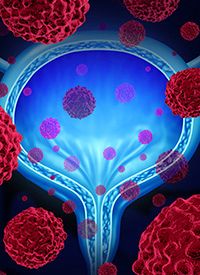Article
Mitomycin C Reduces the Number of Procedures Following NMIBC Recurrence
Author(s):
Chemoresection with mitomycin C, a nonsurgical treatment modality, significantly reduced the need for transurethral resection of bladder tumors or office biopsy and tumor fulguration following recurrence in patients with recurrent nonmuscle invasive bladder cancer.

Chemoresection with mitomycin C, a nonsurgical treatment modality, significantly reduced the need for transurethral resection of bladder tumors (TURBT) or office biopsy and tumor fulguration following recurrence in patients with recurrent nonmuscle invasive bladder cancer (NMIBC), according to long-term results from the DaBlaCa-13 study (NCT03348969).1
The trial included 120 patients with a history of Ta low- or high-grade NMIBC who experienced recurrence. The intervention group (n = 58) received 40 mg/40 mL intravesical mitomycin C 3 times a week for 2 weeks, and TURBT or office biopsy if the response was incomplete. The control group (n = 61) received TURBT or office biopsy and 6 weekly adjuvant instillations.
Investigators found that significantly fewer patients in the intervention group required a procedure during 2 years of follow-up (P <.001). Seventeen (29%; 95% CI, 19%-43%) patients in the mitomycin group had no procedures while no patient in the control group avoided a procedure (0%; 95% CI, 0%-5%). Mitomycin reduced the mean number of procedures by 0.5 procedures per patient, from 2.1 in the control group to 1.6 in the intervention group (P = .077).
When investigators excluded office biopsy and tumor fulguration from the analyses, 26 patients in the intervention group required a TURBT (45%; 95% CI, 0.32-0.58) vs 47 in the control group (77%; 95% CI, 0.65-0.87; P <.001).
“Chemoresection allowed patients with recurrent disease to avoid surgery without affecting long-term oncological outcome,” the investigators concluded.
In prior studies, chemoresection demonstrated a complete response rate of 37% to 70% in patients with intermediate-risk Ta NMIBC in previous results.2-4 Investigators in the DaBlaCa-13 study are assessing short-term intensive chemoresection with mitomycin as a nonsurgical approach to reduce patient discomfort and lower costs.
From January 2018 to August 2021, Danish investigators on the randomized, controlled DaBlaCa-13 study recruited 120 patients with a history of stage Ta low- or high-grade NMIBC upon recurrence with more than 1 papillary tumor smaller than 2 cm. Those who previously received mitomycin or treatment with Bacillus Calmette-Guérin (BCG) within the previous 24 months were excluded.
Patients with Ta low-grade tumors underwent cystoscopy at 4 months. In recurrence-free patients, cystoscopy was repeated after 8 months, then annually. Patients with high-grade tumors underwent cystoscopy and urine cytology every 4 months until 2 recurrence-free years had passed. Subsequently, they followed the regimen for Ta low-grade tumors.
The control group received standard care with TURBT or office biopsy and tumor fulguration followed by adjuvant instillation treatment with mitomycin for low-grade tumors and BCG for high-grade tumors.
The primary end point was the number of patients undergoing a procedure, TURBT or office biopsy and tumor fulguration, within 2 years after entering the study. The secondary end points were recurrence-free survival (RFS) in both groups and serious adverse events in the intervention group.
At baseline, 40 patients in the control group required a TURBT, and 21 patients required office biopsy and tumor fulguration. Twenty-five patients in the intervention group required a
procedure at baseline because of residual tumor following chemoresection. Ten (40%) of the procedures were TURBTs and 15 were office biopsy and tumor fulguration. Investigators concluded the shift from TURBT to office procedure was statistically significant (P = .029).
Investigators observed no difference in the number of patients requiring a procedure because of subsequent recurrences between the intervention (n = 37; 64%; 95% CI, 50%-76%) and control groups (n = 35; 57%; 95% CI, 44%-70%; P = .5). Similarly, there was no difference in the number of TURBTs performed during the follow-up period between the intervention (n = 26; 45%; 95% CI, 32%-58%) and control groups (n = 21; 34%; 95% CI, 23%-48%; P = .2).
The 12-month RFS rates were 36% (95% CI, 24%-50%) in the intervention group and 43% (95% CI, 30%-56%) in the control group. There was no significant statistical difference between groups (P = .5). Investigators observed no difference in RFS for low- or high-grade disease in the intervention group (P = .6).
Sixteen (28%) patients in the intervention group and 13 (21%) in the control group had recurrence at first follow-up (P = .4). Investigators concluded that the number of tumors at first recurrence was not statistically different between the 2 groups (P = .12). In the intervention group, there were significantly fewer recurrences among responders to chemoresection compared with nonresponders (P = .004).
References
- Lindgren MS, Hansen E, Azawi N, Nielsen AM, Dyrskjøt L, Jensen JB. DaBlaCa-13 study: oncological outcome of short-term, intensive chemoresection with mitomycin in nonmuscle invasive bladder cancer: primary outcome of a randomized controlled trial. J Clin Oncol. Published online October 12, 2022. doi:10.1200/JCO.22.00470
- Lindgren MS, Bue P, Azawi N, et al. The DaBlaCa-13 study: Short-term, intensive chemoresection versus standard adjuvant intravesical instillations in non-muscle-invasive bladder cancer—a randomised controlled trial. Eur Urol. 2020;78(6):856-862. doi:10.1016/j.eururo.2020.07.009
- Colombo R, Rocchini L, Suardi N, et al. Neoadjuvant short-term intensive intravesical mitomycin C regimen compared with weekly schedule for low-grade recurrent non-muscle-invasive bladder cancer: preliminary results of a randomized phase 2 study. Eur Urol. 2012;62(5):797-802. doi:10.1016/j.eururo.2012.05.032
- Mostafid AH, Porta N, Cresswell J, et al. CALIBER: a phase II randomized feasibility trial of chemoablation with mitomycin-C vs surgical management in low-risk non-muscle-invasive bladder cancer. BJU Int. 2020;125(6):817-826. doi:10.1111/bju.15038





%20(2)%201-Recovered-Recovered-Recovered-Recovered-Recovered.jpg?fit=crop&auto=format)

%20(2)%201-Recovered-Recovered-Recovered-Recovered-Recovered.jpg?fit=crop&auto=format)
%20(2)%201-Recovered-Recovered-Recovered-Recovered-Recovered.jpg?fit=crop&auto=format)